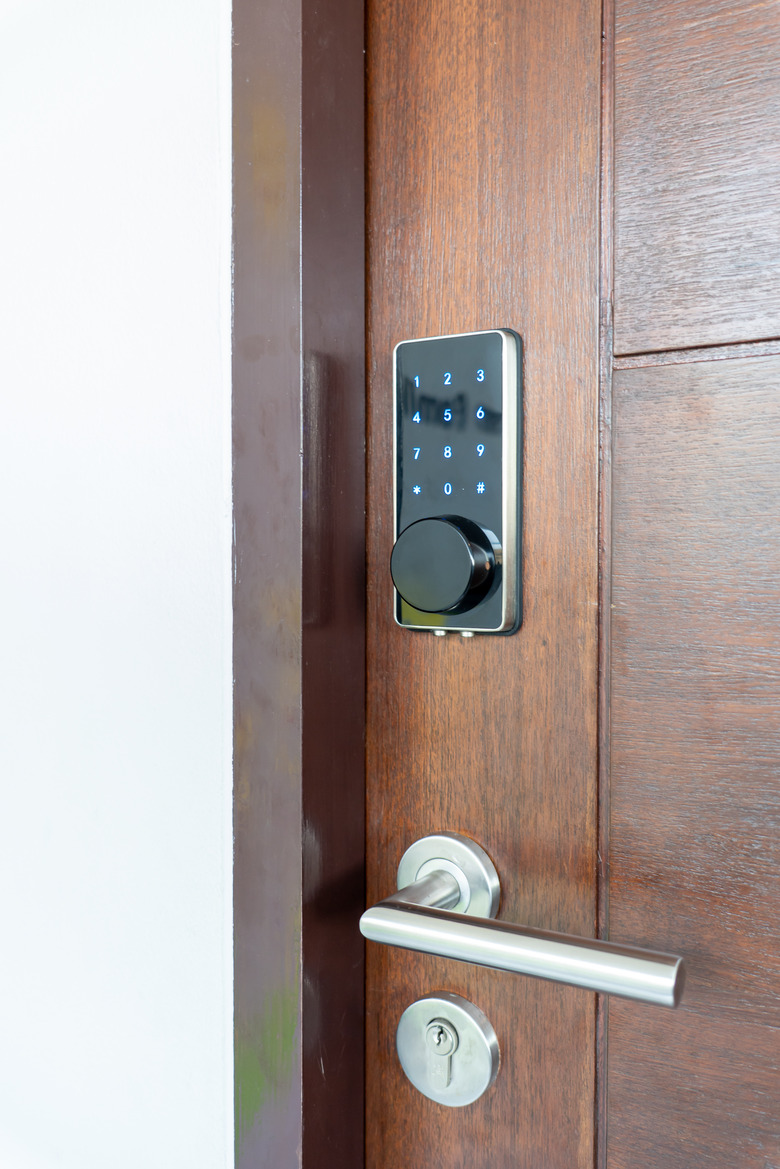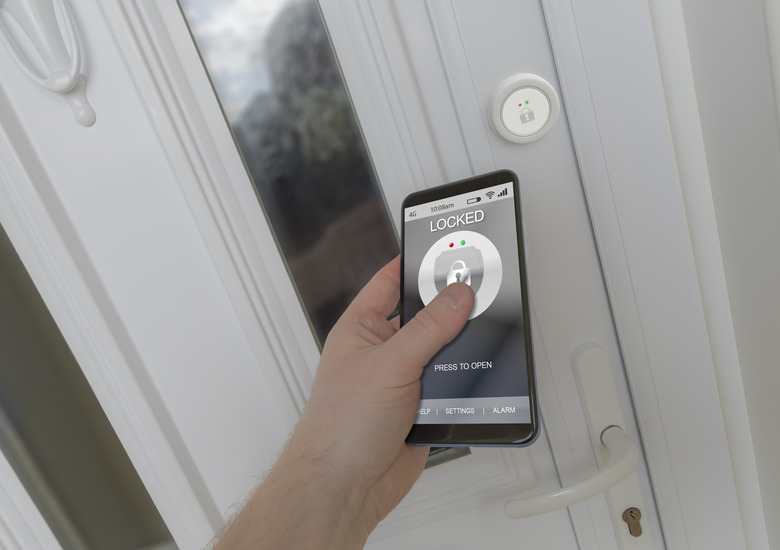How To Install A Smart Lock
We may receive a commission on purchases made from links.
If you're in the habit of forgetting your house keys, a smart lock is for you — but that's just one reason you'll appreciate having one. Instead of a key, all you have to remember is a passcode, and that's something you can give to friends so they can water your plants while you're away. In fact, if you install a Wi-Fi-enabled smart lock, you can open the door yourself using your smartphone, even while vacationing in the Bahamas.
A smart lock isn't much different from a keyed deadbolt, having the same internal mechanisms to operate it, including a bolt and a tailpiece. It fits in the same hole in your door that is occupied by your present deadbolt, and if you're installing one in a brand-new door, you can use the template for a conventional deadbolt to drill the holes. Installation is similar to that for a regular deadbolt, the only difference being the addition of the keypad or Wi-Fi interface. You can put it on the outside of your front door with a thumb turn on the inside, or you can install a smart lock interface on the inside and keep your keys in your pocket so you can use them to open the door when you forget your smartphone.
Why You Might Want a Smart Lock
Why You Might Want a Smart Lock
One of the most common smart home components, a smart lock can interface with Google Assistant or Amazon Alexa and allow you to lock and unlock the door with a voice command. If you keep your smartphone in your pocket, Bluetooth-enabled smart locks can sense it and can open the door as you walk up the front steps and lock it behind you. That's convenient for sure, but not all smart locks are this smart. Some have digital keypads that accept a four- or five-digit passcode, and you have to enter that the old-fashioned way by tapping the code with your finger, but even this type of smart lock gives your front door the high-tech look of the internet age.
Landlords are among those who appreciate the passcode feature because it allows them to grant access to tenants without having another key made, and when tenants move out, there's no need to chase after keys or change the lock. All that's needed is to change the passcode to a new one, which can be relayed to new tenants by text or email. Coupled with a video doorbell, a smart lock offers the functionality for unlocking the door and letting someone into the house from a remote location.
Typical Components of a Smart Lock
Typical Components of a Smart Lock
A smart lock is basically a deadbolt; it works the same way and has most of the same parts. The only difference is the electronic control mechanism that takes the place of either the keyhole or the thumb turn. The same home security companies that make conventional deadbolts, including Kwikset and Schlage, manufacture smart locks, and they also manufacture faceplates that can be added to an existing deadbolt.
The faceplate contains all the circuitry that confers the electronic functionality, but the most important components are the gears that operate the lockset. Faceplates designed to be installed on existing deadbolts usually come with an adapter that fits on the tailpiece (turnpiece), which is the rod that extends through the lock mechanism and operates the bolt. When the faceplate is connected to the tailpiece with the appropriate adapter, the gears in the faceplate open and close the lock. The other important component of a smart lock is a mounting plate to secure the keyhole or thumb turn on the opposite side of the door and to provide a base on which to install the faceplate.
Installing a Smart Lock on a New Door
Installing a Smart Lock on a New Door
If you're installing a smart lock on a door without an existing deadbolt, you'll have to drill a hole in the door face, which is usually 2 1/8 inches in diameter, and a 7/8- or 1-inch hole in the edge of the door to accommodate the bolt. The diameters of the holes as well as the position of the larger one relative to the edge of the door vary with the lock model, so to make sure you drill them correctly, you should use the template that comes with the lock.
While you can drill the smaller hole with a spade bit, you'll need a hole saw for the larger one, and a simple trick will prevent the saw from chipping out the door material when it breaks through. It doesn't matter whether you start drilling from the inside or outside of the door as long as you finish from the other side. Stop drilling when the pilot bit breaks through. Go to the other side of the door, insert the pilot bit in the hole and finish the larger hole. Then, using the template as a guide, drill the smaller hole in the edge of the door.
Things Needed
How to Install a Smart Lock
How to Install a Smart Lock
When it comes to replacing an existing deadbolt, homeowners have options, but anyone who knows how to replace a deadbolt with a smart lock that has a keypad on one side of the door and an electronic faceplate on the other side can install most other types.
1. Remove the Existing Deadbolt
Unscrew the two screws holding the thumb turn to the door using a Phillips screwdriver and remove the thumb turn and the key cylinder on the outside of the door. Unscrew the deadbolt plate from the side of the door and pull out the bolt assembly. You can also unscrew the strike plate from the door frame if you want to replace it with the one that comes with the new lock. You can also use a security strike plate that adds protection against break-ins.
2. Install the New Bolt Assembly
Look for an arrow on the bolt assembly and install the bolt with this arrow pointing up. If there's no arrow, the bolt can go in either way. You may have to widen the mortise in the edge of the door with a hammer and chisel so the deadbolt plate will fit inside it. When the deadbolt plate is snugly nestled in the mortise, the cam slot should be centered in the hole in the door frame. Screw the bolt plate to the edge of the door.
3. Slip On the Key/Keypad Assembly
Slip the rod of the key/keypad assembly through the cam slot, feed the wire through the hole and push the key/keypad assembly flush against the outside of the door. Hold it there while you install the mounting plate.
4. Attach the Mounting Plate
Line up the rods on the mounting plate with the holes in the cam assembly and feed the wire through the hole at the bottom of the mounting plate. Push the mounting plate flush against the door and then thread the two screws that come with the assembly into the holes on the mounting plate and tighten them with a screwdriver.
5. Install the Faceplate
Plug the wire into the faceplate, hook the faceplate onto the mounting plate and secure it to the lock assembly with the screws that are provided. When the faceplate is secure, install new batteries and follow the instructions for calibrating the lock. The procedure usually involves holding down a button on the keypad or touching the touchscreen while the mechanism figures out which side of the door it's on and operates the deadbolt a few times.

